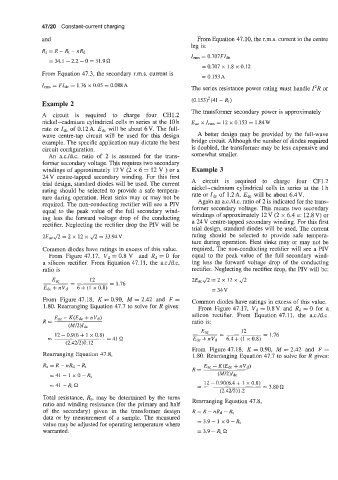Page 487 - Battery Reference Book
P. 487
47/20 Constant-current charging
and From Equation 47.10, the r.m.s. current in the centre
leg is:
R, =R - Rt - nRd
I,, = 0.707FIdc
= 34.1 - 2.2 - 0 = 31.9C2
= 0.707 x 1.8 x 0.12
From Equation 47.3, the secondary r.m.s. current is
= 0.153 A
I,, = FIdc = 1.76 X 0.05 = 0.088 A
The series resistance power rating must handle Z2R or
(0.153)2(41 - Rt)
Example 2
The transformer secondary power is approximately
A circuit is required to charge four CH1.2
nickel-cadmium cylindrical cells in series at the 10 h E, x I,, = 12 x 0.153 = 1.84W
rate or zdc of 0.12A. &c will be about 6V. The full-
wave centre-tap circuit will be used for this design A better design may be provided by the full-wave
example. The specific application may dictate the best bridge circuit. Although the number of diodes required
circuit configuration. is doubled, the transformer may be less expensive and
An a.c.1d.c. ratio of 2 is assumed for the trans- somewhat smaller.
former secondary voltage. This requires two secondary
windings of approximately 12V (2 x 6 = 12 V ) or a Example 3
24V centre-tapped secondary winding. For this first
trial design, standard diodes will be used. The current A circuit is required to charge four CF1.2
rating should be selected to provide a safe tempera- nickel-cadmium cylindrical cells in series at the 1 h
ture during operation. Heat sinks may or may not be rate or Idc of 1.2 A. Edc will be about 6.4 V.
required. The non-conducting rectifier will see a PIV Again an a.c./d.c. ratio of 2 is indicated for the trans-
equal to the peak value of the full secondary wind- former secondary voltage. This means two secondary
ing less the forward voltage drop of the conducting windings of approximately 12V (2 x 6.4 = 12.8V) or
rectifier. Neglecting the rectifier drop the PIV will be a 24 V centre-tapped secondary winding. For this first
trial design, standard diodes will be used. The current
2Eac,/2 = 2 x 12 x 42 = 33.94V rating should be selected to provide safe tempera-
ture during operation. Heat sinks may or may not be
Common diodes have ratings in excess of this value. required. The non-conducting rectifier will see a PIV
From Figure 47.17, Vd = 0.8 v and Rd = 0 for equal to the peak value of the full secondary wind-
a silicon rectifier. From Equation 47.1 1, the a.c./d.c. ing less the forward voltage drop of the conducting
ratio is rectifier. Neglecting the rectifier drop, the PIV will be:
Ea, - 12 = 1.76 2Eac42 = 2 x 12 x ,/2
-
Edc + nVd 6 + (1 X 0.8) = 34v
From Figure 47.18, K = 0.90, M = 2.42 and F = Common diodes have ratings in excess of this value.
1.80. Rearranging Equation 47.7 to solve for R gives: From Figure 47.17, vd = 0.8V and Rd = 0 for a
silicon rectifier. From Equation 47.1 1, the a.c.1d.c.
ratio is:
Eac - 12
-
- 12 - 0.9(6 + 1 x 0.8) =4lQ Edc + nVd - 6.4 + (1 X 0.8) = 1.76
(2.42/2)0.12
From Figure 47.18, K = 0.90, M = 2.42 and F =
Rearranging Equation 47.8, 1.80. Rearranging Equation 47.7 to solve for R gives:
R,=R-nRd-Rt
= 41 - 1 x 0 -Rt
=41 -RtQ - 12 - 0.90(6.4 + 1 x 0.8) = 3.80Q
-
(2.42/2)1.2
Total resistance, Rt, may be determined by the turns
ratio and winding resistance (for the primary and half Rearranging Equation 47.8,
of the secondary) given in the transformer design R = R - nRd - Rt
data or by measurement of a sample. The measured
value may be adjusted for operating temperature where = 3.9 - 1 x 0 - Rt
warranted. = 3.9 - Rt Q

